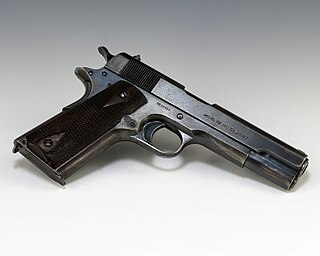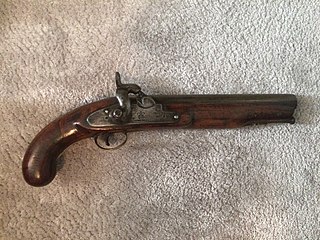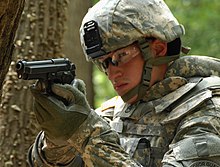
A carbine is a long gun that has a barrel shortened from its original length. Most modern carbines are rifles that are compact versions of a longer rifle or are rifles chambered for less powerful cartridges.

A firearm is any type of gun that uses an explosive charge and is designed to be readily carried and used by an individual. The term is legally defined further in different countries.

The Lee–Enfield is a bolt-action, magazine-fed repeating rifle that served as the main firearm of the military forces of the British Empire and Commonwealth during the first half of the 20th century, and was the standard service rifle of the British Armed Forces from its official adoption in 1895 until 1957.

A sidearm is an individual-served weapon that is kept at one's side and can be rapidly accessed if needed. A sidearm may be carried alone or as an ancillary weapon to a more frequently-used primary weapon. The term historically referred to swords, daggers, and similar small melee weapons kept at one's side in a sheath, and in modern combat dominated by ranged weapons, sidearms are often defined as handguns that are similarly kept in a holster.
A semi-automatic firearm, also called a self-loading or autoloading firearm, is a repeating firearm whose action mechanism automatically loads a following round of cartridge into the chamber and prepares it for subsequent firing, but requires the shooter to manually actuate the trigger in order to discharge each shot. Typically, this involves the weapon's action utilizing the excess energy released during the preceding shot to unlock and move the bolt, extracting and ejecting the spent cartridge case from the chamber, re-cocking the firing mechanism, and loading a new cartridge into the firing chamber, all without input from the user. To fire again, however, the user must actively release the trigger, allow it to "reset", before pulling the trigger again to fire off the next round. As a result, each trigger pull only discharges a single round from a semi-automatic weapon, as opposed to a fully automatic weapon, which will shoot continuously as long as the ammunition is replete and the trigger is kept depressed.

A semi-automatic pistol is a handgun that automatically ejects and loads cartridges in its chamber after every shot fired. Only one round of ammunition is fired each time the trigger is pulled, as the pistol's fire control group disconnects the trigger mechanism from the firing pin/striker until the trigger has been released and reset.

The Webley Revolver was, in various designations, a standard issue service revolver for the armed forces of the United Kingdom, and countries of the British Empire and the Commonwealth of Nations, from 1887 to 1970.

Webley & Scott is an arms manufacturer founded in Birmingham, England. Webley produced handguns and long guns from 1834 to 1979, when the company ceased to manufacture firearms and instead turned its attention to producing air pistols and air rifles. In 2010 Webley & Scott restarted the production of shotguns for commercial sale.
This is an index of lists of weapons.

The Type 26 or Model 26 "hammerless" revolver was the first modern revolver adopted by the Imperial Japanese Army. It was developed at the Koishikawa Arsenal and is named for its year of adoption in the Japanese dating system. The revolver saw action in conflicts including the Russo-Japanese War, World War I and World War II.

The Smith & Wesson Model 10, previously known as the Smith & Wesson .38 Hand Ejector Model of 1899, the Smith & Wesson Military & Police or the Smith & Wesson Victory Model, is a K-frame revolver of worldwide popularity. In production since 1899, the Model 10 is a six-shot, .38 Special, double-action revolver with fixed sights. Over its long production run it has been available with barrel lengths of 2 in (51 mm), 3 in (76 mm), 4 in (100 mm), 5 in (130 mm), and 6 in (150 mm). Barrels of 2.5 inches (64 mm) are also known to have been made for special contracts. Some 6,000,000 of the type have been produced over the years, making it the most-produced handgun of the 20th century.

A handgun is a firearm designed to be usable with only one hand. It is distinguished from a long gun which needs to be held by both hands and braced against the shoulder. Handguns have shorter effective ranges compared to long guns, and are much harder to shoot accurately. While most early handguns are single-shot pistols, the two most common types of handguns used in modern times are revolvers and semi-automatic pistols, although other handguns such as derringers and machine pistols also see infrequent usage.

A pistol is a type of handgun, characterized by a barrel with an integral chamber. The word "pistol" is derived from the Middle French pistolet, meaning a small gun or knife, and first appeared in the English language c. 1570 when early handguns were produced in Europe. In colloquial usage, the word "pistol" is often used as a generic term to describe any type of handgun, inclusive of revolvers and the pocket-sized derringers.

The Charlton automatic rifle was a fully automatic conversion of the Lee–Enfield rifle, designed by New Zealander Philip Charlton in 1941 to act as a substitute for the Bren and Lewis gun light machine guns which were in severely short supply at the time.

An ancillary weapon is a weapon used to supplement a primary or main weapon in the event it cannot be used or is ineffective in a certain application or situation. Examples of ancillary weapons to main weapons include a melee weapon to a ranged weapon, a sidearm to a service weapon, or a light gun to a heavy cannon.

A pistoleer is a mounted soldier trained to use a pistol, or more generally anyone armed with such a weapon. It is derived from pistolier, a French word for an expert marksman.

The M27 Infantry Automatic Rifle (IAR) is a 5.56mm, select-fire assault rifle, based on the HK416 by Heckler & Koch. It is used by the United States Marine Corps (USMC) and is intended to be issued to all infantry riflemen as well as automatic riflemen. The USMC initially planned to purchase 6,500 M27s to replace a portion of the M249 light machine guns employed by automatic riflemen within Infantry and Light Armored Reconnaissance Battalions. Approximately 8,000–10,000 M249s will remain in service with the Marine Corps to be used at the discretion of company commanders. In December 2017, the Marine Corps announced that it would equip every member of an infantry squad with the M27, supplanting the M4 carbine which would be retained at the platoon leadership positions and above.

The Enfield No. 2 was a British top-break revolver using the .38 S&W round manufactured from 1930 to 1957. It was the standard British/Commonwealth sidearm in the Second World War, alongside the Webley Mk IV and Smith & Wesson Victory Model revolvers chambered in the same calibre. Note that in the context of British service revolvers, the .38 S&W cartridge has often been called ".380".

















